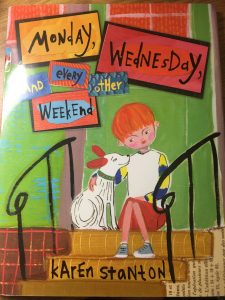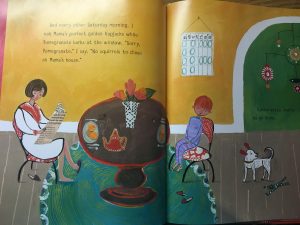Title: Monday, Wednesday, and Every Other Weekend
 Author: Karen Stanton
Author: Karen Stanton
Illustrator: Karen Stanton
Publisher: Feiwel & Friends, 2014
Number of Pages: 40 pages
Tags:
Genre: Realistic Fiction
Analysis: In this story, Henry’s parents are divorced and he lives in two different houses. On Monday, Wednesday, and every other weekend Henry and his dog, Pomegranate, live with their mom in her apartment. On Tuesday, Thursday, and every other weekend, they live with their dad in his new house. Pomegranate gets confused with the new changes and wants to go back to his old home.
This story serves as a mirror, allowing children with divorced parents to see their own life reflected in the story. It deals with the many changes that take place during a divorce. The images also include children of different cultures which creates diversity. In addition, the images are created using different texts from French, Italian, and other languages. Children who have not experienced this significant change in their life can grasp an idea of how other children may feel in this situation.
The images are very colorful and lively, creating a positive mood. They are made with a mixture of acrylic paint and some collage materials. In addition, it is obvious through the illustrations that Mama’s and Papa’s house are very different places. Mama lives in an apartment while Papa has his own house down the street. In the images, the reader can see the calendars shown on the wall. In each house, the calendar on the wall shows th e days that Henry will spend there. The author and illustrator uses Pomegranate to display most of the emotions felt by children during times of divorce within their family. For example, Pomegranate runs away and Henry knows just where to find him. Henry runs to his old house, “the house where we all used to live together,” and finds Pomegranate there. However, she portrays the main character Henry as happy and well adjusted to his new life, but does not underplay the emotions Henry experiences. The author also portrays each parent positively, listing the perks of living in each house. While searching for the dog, the illustrator creates a map that allows the reader to see the town in which Henry lives. The dots on the map show where Henry goes to find his dog. This book handles the feelings surrounding divorce in a positive way. This book can be used by families who are struggling to establish a new way of living after divorce. This book is relatable to a lot of children who experience this shift in family dynamics.
e days that Henry will spend there. The author and illustrator uses Pomegranate to display most of the emotions felt by children during times of divorce within their family. For example, Pomegranate runs away and Henry knows just where to find him. Henry runs to his old house, “the house where we all used to live together,” and finds Pomegranate there. However, she portrays the main character Henry as happy and well adjusted to his new life, but does not underplay the emotions Henry experiences. The author also portrays each parent positively, listing the perks of living in each house. While searching for the dog, the illustrator creates a map that allows the reader to see the town in which Henry lives. The dots on the map show where Henry goes to find his dog. This book handles the feelings surrounding divorce in a positive way. This book can be used by families who are struggling to establish a new way of living after divorce. This book is relatable to a lot of children who experience this shift in family dynamics.
